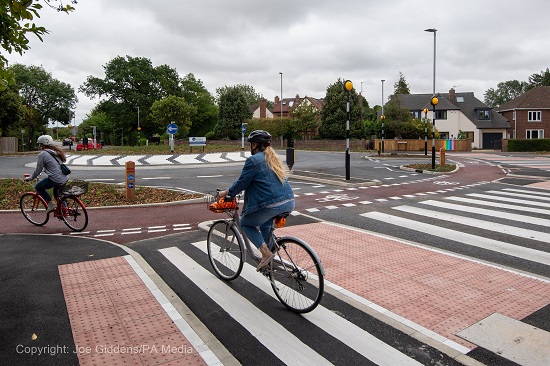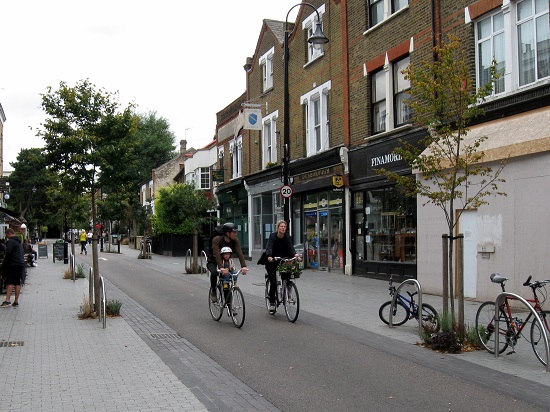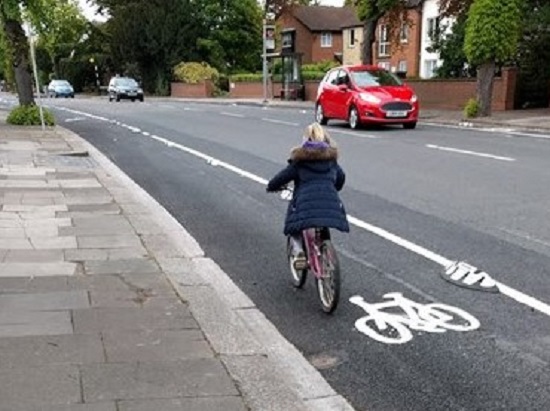Last month the Government set out a bold vision to make cycling “the natural first choice for many journeys” by ensuring that any new cycle infrastructure is accessible to everyone “from 8 to 80 and beyond”.
The plan, outlined in a 52-page policy document called “Gear Change”, is nothing short of a travel revolution to make cycling a mass form of transport. This isn’t the first time we’ve heard these words but this time it’s backed up with the actions required by all levels of government to achieve it, as well as £2bn of dedicated funding over the next five years.
However, only those councils which have plans to meet the challenge will receive funding. Councils with unambitious plans will receive nothing. Will West Sussex step up a gear, or will we be left behind?
There is – finally – a recognition at the highest level of government that “paint is not infrastructure”: that the only way to enable more people to cycle is by building better quality infrastructure. The vision makes clear that shared-use routes mixing cyclists with pedestrians will no longer be acceptable. Routes must be built to the highest international standards, or will not be built at all.
Specifically it commits to building thousands of miles of new protected bike lanes:
“The routes must be direct. They must be continuous, not giving up at the difficult places. They must serve the places people actually want to go – often major public transport corridors – and the journeys they actually want to make. If it is necessary to reallocate roadspace from parking or motoring to achieve this, it should be done.”
The Government also pledges to help local authorities implement other transformative changes, such as closing roads to through traffic, low traffic neighbourhoods and “school streets” to reduce through traffic at school drop-off and pick-up times.
Twelve “willing authorities” will be selected for “intense investment” to build mini-Hollands, like the hugely successfully Waltham Forest.
The National Cycle Network will be improved, with an emphasis on sections that are useful for everyday journeys. Funding will be increased, barriers will be removed and the proportion that is traffic-free and has an all-weather smooth surface will be increased. No more gravel!
To achieve all of this the Government recognises that the quality of cycle infrastructure must “dramatically improve”. To give teeth to this they have issued revised national guidance on Cycle Infrastructure Design (LTN 1/20). All schemes must meet these higher standards or will fail to secure funding.
A new Active Travel England inspectorate – along the lines of Ofsted – will be set up to ensure we no longer have to see sub-standard infrastructure.
As cycling and walking minister Chris Heaton-Harris says in the foreword:
“Too much [existing] cycling infrastructure provides little protection from motorized traffc and gives up at the very places it is most needed. Some is actually worse than nothing, because it entices novice cyclists with the promise of protection, then abandons them at the most important places.”
The notorious “crap cycle lane” should become a thing of the past.
The inspectorate will have the power to withhold funding from badly designed cycling schemes and to refuse funding for any highways programmes that do not cater adequately for active travel.
New powers will be given to local authorities allowing them, rather than the police, to enforce moving traffic offences such as disregarding one-way systems or entering mandatory cycle lanes.
There are a raft of complimentary measures such as cycle training for anyone who wants it, grants for e-bikes and plans for more and better cycle parking.
As if this wasn’t enough, the Government has also announced a consultation on changes to the Highway Code, many of which are applicable to cycling, such as a minimum overtaking distance and continuous right of way across side roads.
New design standards
The revised Cycle Infrastructure Design guidance (LTN 1/20), which come into force immediately, sets a “national default position where high quality cycle infrastructure is provided as a matter of course in local highway schemes”.
Cycle infrastructure should be planned and designed for everyone, such that routes are accessible to all – regardless of age, gender, ethnicity or disability:
- On urban streets cyclists must be physically separated from pedestrians
- On roads with high volumes of motor traffic cyclists must have physical protection
- Cycle infrastructure should be designed for significant numbers of cyclists, as well as for non-standard cycles
- Routes must join together to create a holistic, connected network
- Schemes must be easy and comfortable to ride
- Surfaces must be hard, smooth, level, durable, permeable and safe in all weathers
- Barriers and dismount signs should not be used
- Once routes are built they must be maintained properly afterwards
In what may prove to be a hugely significant consideration for councils, if they don’t provide cycling infrastructure that meets the new standards they may not get funding for their other transport schemes:
“To receive Government funding for local highways investment where the main element is not cycling or walking, there will be a presumption that schemes must deliver or improve cycling infrastructure to the standards in LTN 1/20.”
Perhaps most welcome of all, traffic engineers must have experience of actually using the paths they build and should get out and cycle the routes they are designing.
A measurable quality threshold has been introduced. All road projects funded by the DfT must now have a Cycling Level of Service rating of at least 70% to be considered for funding:
“These higher standards will make clear that schemes which consist mainly of paint, which make pedestrians and cyclists share the same space, or which do not make meaningful change to the status quo on the road, will not be funded.”
The Government recognises the mistakes of the past with stop-start funding:
“Delivering good schemes needs a pipeline of assured funding. We will end the stop-go nature of previous cycling and walking funding, allowing local authorities and others to plan in a long-term way.”
This assured funding will allow local authorities to plan their cycling and walking programmes and budgets in a long-term way, just as they do with roads programmes and budgets.
The revised design standards laid out in LTN 1/20 apply immediately. It could be argued that any schemes in the pipeline now need a Cycling Level of Service score of 70% and any developments in the planning process need to be reworked to conform to LTN 1/20.
What does this mean for example for the North of Horsham and Novartis developments?





Having just returned from the Netherlands, this resonates with me particularly strongly.
It’s worth bearing in mind that the Netherlands achieved their current state — and the huge benefits to quality of life and cost of living that go with it — with certain important sacrifices:
1) They were willing to tear up a lot of roads, especially rural ones, and do a lot of construction, including not just thousands of miles of bike paths but an entire infrastructure of replanned roundabouts, new crossing lights, and more.
2) They overhauled their traffic laws.
3) They took advantage of the fact that large parts of the country are already flat, and already incredibly densely populated (it’s all ‘brownfield’ in Holland really), and were not reluctant to pave over yet more of the country to build bike paths.
I don’t think the UK can, or wants to, make these sacrifices at a national level. So we’re not going to get a Netherlands result.
But I think the DfT’s plans are nevertheless extremely sensible. While nationwide mandates are unlikely to stick, tying funding to sensible measures such as CLoS is a great way to empower those projects and local authorities that are able and willing to change, without the risk of getting bogged down in trench warfare against those who are unable or unwilling.
WSCC and HDC are certainly able. Whether they are willing remains to be seen.
Perhaps introducing laws might help , the 1 1/2 meter rule on passing has been made a law in some European countries. And what about a poster campaign to go with it . Cars MUST be prepared to cooperate otherwise the cycle revolution will fizzle out . A bit like all those cycle paths that were built in the new towns just when the promise of car ownership was on people’s lips . For gods sake avoid going all safety wise on the part of the cyclist making helmet laws . Holland must be the model to follow
This is such good news for all those who’ve suffered poor planning and cost savings in favour of road traffic over decades. In particular the statement that on urban streets and those with high traffic volumes cyclists must have physical protection. I would say this includes all proposed and existing cycle routes in urban Horham and the intensely busy through routes such as the muderous A264.
Looking at the picture above of the little six year old wobbling along a busy main road with just a white line between her and the traffic would not encourage me to let my child cycle there, at the very least they could have put kerb stones to prevent cars from veering into her when their concentration is lacking, which is so often the case.
However, we’re reliant on HDC and WSCC to show some leadership and proactive action here and that this is their priority over roads made for cars and help support our commitment to climate change. The one thing we’ve all benefited from recently was the huge increase in air quality, with more peaceful traffic free streets and more wildlife, fast dissappearing again now lockdown is easing, but it shows it can be done, if there’s the will to.
So, as North of Horsham has yet to start beyond removal of some trees at the site edge, will we see a Dutch style roundabout now to allow their residents to cycle safely into Horsham as highlighted in their marketing plan? Will the Horsham to Crawley cycleway ‘missing link’ finally be properly connected with an all weather surface? Will the frankly dangerous conflicts of cyclists, pedestrians and traffic, particularly at junctions finally receive dedicated physically separated lanes and not just cheap white lining? If the long wait for a few traffic cones to come out of store at the highways depot and be placed on a small section of Albion Way to create a pop up lane (still awaited last time I looked) are an indication of enthusiasm to cooperate here, I’m not sure I’ll be holding my breathe. I do though anticipate with some interest the sight of our senior council planning consultants, getting out of their Jaguars and 4×4’s and wobbling along the streets to test any cycle infrastructure planned, it may come as something of a shock to them and to us!
Re: the Albion Way traffic cones, I understand that there is one team in West Sussex implementing the ‘popups’ and that they currently have several projects on their list before they reach Horsham — so the delay isn’t due to HDC. It would be interesting to understand how the cost and complexity of placing cones can be so high, but I’m not privy to that sort of insight.
Horsham’s cycling provision is particularly regrettable. I think what’s good about the DfT’s plan is that it has a chance to ‘flow around’ local authorities that aren’t interested, and direct funding to those who are interested.
Well the Albion Way cost is £14,800. I would imagine the survey/design component would use most of that leaving maybe as little as £5,000 for the actual traffic cones /bollards/signage to be installed. In road redesign project terms, £14,800 is really not a lot. The Horsham scheme is the lowest priced out of the 7 schemes. Also the money may be clawed back should schemes not be started within four weeks of the allocation and completed within a further eight weeks. The announcements about the schemes were made at end of June, so if the money was allocated then, it might be gone by now anyway.